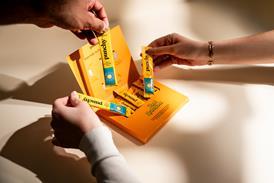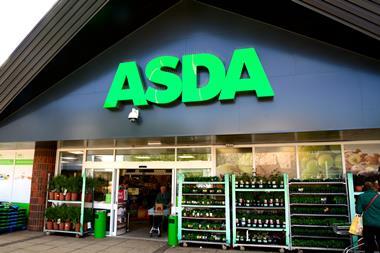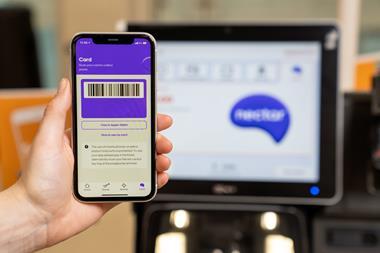What impact will Asda’s bogof tactics have on its rivals, asks James Durston
For the first time ever, Asda is telling its customers to bogof. In the past three months, the market’s purest EDLP protagonist has launched a buy-one-get-one-free campaign that takes its revenue derived from multibuy activity to its highest level for at least two years. What is more, the other multiples are following suit, and the stage is set for a tussle for bargain-hunting consumers.
But what has brought about the change of heart, and is it here to stay?
One year ago, Asda came bottom of a table ranking retailers by the sales values of their promotions (‘The great EDLP paradox’ The Grocer, July 10 2004, p28). This was no surprise to anyone, as Asda had always prioritised its EDLP philosophy.
But for the eight weeks to June 19, ACNielsen data shows that 12.4% of Asda’s net sales came from multibuys (which include bogofs and all X-for-£Y promotions), the highest this figure has been since October 2002, when it stood at 10.8%. Now, the signs are that the rate of growth will accelerate - and the driver will be the humble bogof.
Mintel’s POS+ database shows that until May this year, Asda hadn’t even dipped a toe into the bogof pond. Then in May, 28 lines were given the treatment. In June this went up to 47, and although data for July is incomplete, 64 lines are now on bogof.
TNS data supports the findings and shows considerable increases in multibuys by Asda and Tesco over the past year.
Ed Garner, communications director for TNS Worldpanel UK, says: “This is definitely significant. There is an overall desire to give things a kick at Asda, and bogofs are a sure way to get rid of boxes, shifting product out of the store and into the house.”
Any mention of a change of strategy has always been rebuffed entirely, or at the very least, qualified. Asda likes to point out that it operates on a so-called EDLP+ mechanic.
But anyone who has been reading The Grocer in recent months can’t have helped but notice a sea change. Last month Andy Bond, Asda president, admitted it “will do more promotional activity with the aim of being the consumers’ champion” (‘Growth tactics? Simple!’ The Grocer, June 18, p37).
Alexander Schwendtner, operations manager for Mintel’s POS+, says: “My guess would be that Asda realises EDLP isn’t working so well any more, especially against the backdrop of Tesco’s growth and its focus on low prices, so it is trying something new.
“Asda’s bogofs are across a wide range of categories including bakery, dairy, and fruit & veg, so I think it could be experimental at this stage to see how things go.”
The move already appears to have had an impact on the other multiples.
Tesco has increased its multibuy promotions over the past quarter and 15.3% of its net sales now come from multibuys, says ACNielsen. Again, this is the highest this figure has been since October 2002, when it was 10.8%
Mintel’s data also shows that in May, the month that Asda took the plunge, Tesco jumped from 164 bogof lines to 203. And in both June and July Tesco has run more bogofs than average. Surely it couldn’t be trying to put a squeeze on Asda’s position?
Tesco, of course, disagrees, saying, simply, that “bogofs and multibuy promotions have proved to be the most popular type of promotion for our customers”.
But Schwendtner says that if Tesco is also promoting its bogofs more heavily, this would show it is trying to distract consumers from Asda’s bogof tactics. He says: “It would be interesting to investigate whether Tesco has promoted bogofs more heavily through advertising and banners.”
When asked to comment on its promotional strategy, Tesco responds: “We have worked to make the bogof and multibuy more visible, both throughout the store and through advertising.”
Data for Sainsbury and Morrisons also show significant increases in the number of bogofs over the first two quarters this year. And sales-wise, similar trends can be seen in most of the other multiples.
ACNielsen shows that over the past year, sales from multibuys at Somerfield are up 3.71 percentage points to 16.91%. Safeway’s figures rose 2.73 percentage points to 18.38% to be closer in line with Morrisons’ activity, and Sainsbury’s multibuy net sales were up 1.39 percentage points to 16.58%.
However, the reluctance of any of the multiples to talk candidly about the recent rise in bogofs underlines the uncertainty with which they regard the dynamic. Garner explains that it’s not simply a case of putting a sticker on the packaging. “The trick is for these promotions to take place against a background of reasonable pricing,” he says.
He also points out that not all categories lend themselves to the bogof format, and that certain products such as shampoo, where customer loyalty to a particular brand is very low, can be adversely affected in the long term. “When I worked on promotions of shampoo at Boots, we found that people actually became loyal to the ‘bogof brand’ rather than to any real brand,” he says.
So, remove the promotion, and you run the risk of removing your customer. Garner adds: “These things have to be limited, otherwise you erode the value of the market, as is happening in the beer sector at the moment. Why would people pay full price when they know they can get it on promotion round the corner?”
Asda’s marketers will have to keep a close eye on their figures as well as their competitors’, if bogofs are to help in achieving the growth of previous years.
In any case, there is some way to go before Asda’s bogofs are as ubiquitous as Morrisons’, say, which on average has more than 300 bogofs running in any month.
Even Tesco, despite a heavy campaign popularising its low prices, usually runs around 150 bogofs during any month.
Not surprisingly for a company whose success is based on an EDLP philosophy, Asda is still loathe to dilute the message. A spokesman says: “It would be wrong to imply there’s been any kind of softening of EDLP - it is the cornerstone of the relationship with our customers. Most of Asda’s price investment is, and will be, in day-in, day-out price cuts.”
But a survey conducted by Mintel found that although Asda shoppers are focused on consistent low prices, 60% of them also look for extra-value promotions such as bogofs.
Schwendtner says: “EDLP does work well, but to be honest Asda needs to look at Tesco getting bigger and bigger, with its own low-price promotions, and work out how to compete. Going forward, EDLP may not be enough and it could even get boring.”
Reaction from the other multiples suggests the threat to their own strategies is bigger than Asda is letting on. Asda’s next move will have to be a considered one, but it could prove to be the spark that lights the fuse.
For the first time ever, Asda is telling its customers to bogof. In the past three months, the market’s purest EDLP protagonist has launched a buy-one-get-one-free campaign that takes its revenue derived from multibuy activity to its highest level for at least two years. What is more, the other multiples are following suit, and the stage is set for a tussle for bargain-hunting consumers.
But what has brought about the change of heart, and is it here to stay?
One year ago, Asda came bottom of a table ranking retailers by the sales values of their promotions (‘The great EDLP paradox’ The Grocer, July 10 2004, p28). This was no surprise to anyone, as Asda had always prioritised its EDLP philosophy.
But for the eight weeks to June 19, ACNielsen data shows that 12.4% of Asda’s net sales came from multibuys (which include bogofs and all X-for-£Y promotions), the highest this figure has been since October 2002, when it stood at 10.8%. Now, the signs are that the rate of growth will accelerate - and the driver will be the humble bogof.
Mintel’s POS+ database shows that until May this year, Asda hadn’t even dipped a toe into the bogof pond. Then in May, 28 lines were given the treatment. In June this went up to 47, and although data for July is incomplete, 64 lines are now on bogof.
TNS data supports the findings and shows considerable increases in multibuys by Asda and Tesco over the past year.
Ed Garner, communications director for TNS Worldpanel UK, says: “This is definitely significant. There is an overall desire to give things a kick at Asda, and bogofs are a sure way to get rid of boxes, shifting product out of the store and into the house.”
Any mention of a change of strategy has always been rebuffed entirely, or at the very least, qualified. Asda likes to point out that it operates on a so-called EDLP+ mechanic.
But anyone who has been reading The Grocer in recent months can’t have helped but notice a sea change. Last month Andy Bond, Asda president, admitted it “will do more promotional activity with the aim of being the consumers’ champion” (‘Growth tactics? Simple!’ The Grocer, June 18, p37).
Alexander Schwendtner, operations manager for Mintel’s POS+, says: “My guess would be that Asda realises EDLP isn’t working so well any more, especially against the backdrop of Tesco’s growth and its focus on low prices, so it is trying something new.
“Asda’s bogofs are across a wide range of categories including bakery, dairy, and fruit & veg, so I think it could be experimental at this stage to see how things go.”
The move already appears to have had an impact on the other multiples.
Tesco has increased its multibuy promotions over the past quarter and 15.3% of its net sales now come from multibuys, says ACNielsen. Again, this is the highest this figure has been since October 2002, when it was 10.8%
Mintel’s data also shows that in May, the month that Asda took the plunge, Tesco jumped from 164 bogof lines to 203. And in both June and July Tesco has run more bogofs than average. Surely it couldn’t be trying to put a squeeze on Asda’s position?
Tesco, of course, disagrees, saying, simply, that “bogofs and multibuy promotions have proved to be the most popular type of promotion for our customers”.
But Schwendtner says that if Tesco is also promoting its bogofs more heavily, this would show it is trying to distract consumers from Asda’s bogof tactics. He says: “It would be interesting to investigate whether Tesco has promoted bogofs more heavily through advertising and banners.”
When asked to comment on its promotional strategy, Tesco responds: “We have worked to make the bogof and multibuy more visible, both throughout the store and through advertising.”
Data for Sainsbury and Morrisons also show significant increases in the number of bogofs over the first two quarters this year. And sales-wise, similar trends can be seen in most of the other multiples.
ACNielsen shows that over the past year, sales from multibuys at Somerfield are up 3.71 percentage points to 16.91%. Safeway’s figures rose 2.73 percentage points to 18.38% to be closer in line with Morrisons’ activity, and Sainsbury’s multibuy net sales were up 1.39 percentage points to 16.58%.
However, the reluctance of any of the multiples to talk candidly about the recent rise in bogofs underlines the uncertainty with which they regard the dynamic. Garner explains that it’s not simply a case of putting a sticker on the packaging. “The trick is for these promotions to take place against a background of reasonable pricing,” he says.
He also points out that not all categories lend themselves to the bogof format, and that certain products such as shampoo, where customer loyalty to a particular brand is very low, can be adversely affected in the long term. “When I worked on promotions of shampoo at Boots, we found that people actually became loyal to the ‘bogof brand’ rather than to any real brand,” he says.
So, remove the promotion, and you run the risk of removing your customer. Garner adds: “These things have to be limited, otherwise you erode the value of the market, as is happening in the beer sector at the moment. Why would people pay full price when they know they can get it on promotion round the corner?”
Asda’s marketers will have to keep a close eye on their figures as well as their competitors’, if bogofs are to help in achieving the growth of previous years.
In any case, there is some way to go before Asda’s bogofs are as ubiquitous as Morrisons’, say, which on average has more than 300 bogofs running in any month.
Even Tesco, despite a heavy campaign popularising its low prices, usually runs around 150 bogofs during any month.
Not surprisingly for a company whose success is based on an EDLP philosophy, Asda is still loathe to dilute the message. A spokesman says: “It would be wrong to imply there’s been any kind of softening of EDLP - it is the cornerstone of the relationship with our customers. Most of Asda’s price investment is, and will be, in day-in, day-out price cuts.”
But a survey conducted by Mintel found that although Asda shoppers are focused on consistent low prices, 60% of them also look for extra-value promotions such as bogofs.
Schwendtner says: “EDLP does work well, but to be honest Asda needs to look at Tesco getting bigger and bigger, with its own low-price promotions, and work out how to compete. Going forward, EDLP may not be enough and it could even get boring.”
Reaction from the other multiples suggests the threat to their own strategies is bigger than Asda is letting on. Asda’s next move will have to be a considered one, but it could prove to be the spark that lights the fuse.


















No comments yet